Pelvic organ prolapse is a common condition that affects women at various life stages, particularly after childbirth or during menopause. It occurs when the pelvic floor muscles and connective tissues weaken, allowing organs like the bladder, uterus, or rectum to shift out of place.
Symptoms may include pelvic pressure, a sensation of vaginal bulging, urinary incontinence, or difficulty with bowel movements. Early recognition of these signs is essential for preventing progression and maintaining long-term pelvic function.
Treatment options vary depending on the severity and individual lifestyle needs. Pelvic floor physical therapy is often the first line of management, utilizing targeted exercises and techniques to strengthen supportive muscles and alleviate symptoms without the need for surgery.
In moderate to severe cases, options like pessary support or surgical intervention may be considered. With proper evaluation and individualized care, women can restore pelvic stability, enhance their quality of life, and regain confidence in their daily activities.
Understanding Pelvic Organ Prolapse
While the most common cases involve the bladder (cystocele) or uterus descending into the vaginal canal, prolapse can also affect the rectum (rectocele) or small intestine (enterocele). Each type may present with different symptoms, ranging from pelvic heaviness and pressure to difficulty emptying the bladder or bowels.
The severity can vary from mild to advanced, influencing treatment decisions and outcomes. A detailed pelvic exam and imaging, when necessary, help classify the type and degree of prolapse to guide personalized care.
Common Causes and Risk Factors
Vaginal childbirth is one of the leading risk factors for pelvic organ prolapse. Prolonged labor, large babies, or perineal trauma can overstretch or damage the pelvic floor muscles, resulting in lasting weakness. The risk increases with multiple deliveries, where repeated strain compromises tissue integrity.
Aging and pelvic floor physical therapy further contribute by reducing estrogen levels and collagen production, both of which are vital for maintaining pelvic support. Early evaluation and targeted care, such as pelvic floor physical therapy, can help address muscular weakness before symptoms progress.
Other contributing factors include chronic straining from constipation, persistent coughing, heavy lifting, and obesity. These conditions repeatedly put pressure on the pelvic floor and gradually weaken the supportive structures. Genetic predisposition may also increase susceptibility, particularly in women with connective tissue disorders.
In some cases, previous pelvic surgeries, such as hysterectomies, can alter anatomical positioning and raise the risk of prolapse. Preventive strategies, including guidance from a qualified pelvic floor physical therapist, can be instrumental in managing early-stage symptoms and improving long-term outcomes.
Recognizing the Signs
Early detection of pelvic organ prolapse symptoms enables timely intervention and better treatment outcomes. Many women initially dismiss mild symptoms as normal signs of aging or temporary discomfort. However, recognizing the characteristic signs allows for prompt evaluation and appropriate management before symptoms significantly impact daily activities and quality of life.
Pelvic Heaviness and Pressure
The sensation of pelvic pressure or heaviness represents one of the most common early symptoms of organ prolapse. Women often describe feeling like something is falling out or sitting heavily in their pelvis. This discomfort typically worsens throughout the day, especially after prolonged standing or physical activity.
Many patients report feeling a bulge or fullness in the vaginal area that may be visible or palpable during bathing or toileting. The pressure sensation can extend to the lower back and may be accompanied by pelvic pain that varies in intensity. Some women notice these symptoms worsen during menstrual periods or times of increased physical stress.
Physical therapy for pelvic floor dysfunction can significantly address these pressure symptoms by strengthening supporting muscles and improving organ positioning. Early intervention with conservative treatments often prevents symptom progression and reduces the need for surgical management.
Bladder, Bowel, and Sexual Changes
Pelvic organ prolapse often interferes with bladder and bowel function. Women may experience urinary frequency, stress incontinence during activities like coughing or exercise, difficulty initiating urination, or a sensation of incomplete emptying. Bowel changes can include constipation, straining, or needing to apply manual pressure to complete a bowel movement.
These symptoms stem from anatomical shifts that disrupt the coordination between muscles and pelvic organs. Sexual health can also be affected. Discomfort during intercourse reduced vaginal sensation, or a physical bulge may interfere with intimacy and lower sexual satisfaction.
These changes are not uncommon, but they can significantly impact the quality of life. Many patients benefit from pelvic floor rehabilitation, which uses tailored exercises and education to restore pelvic function, reduce discomfort, and improve overall confidence in daily and sexual activities.
Non-Surgical Solutions
Conservative treatment approaches offer effective management for many women with pelvic organ prolapse, particularly those with mild to moderate symptoms. These interventions focus on symptom relief, preventing progression, and improving quality of life without surgical risks. Many patients achieve significant improvement through dedicated participation in conservative treatment programs tailored to their specific needs and circumstances.
Lifestyle Adjustments
Weight management plays a crucial role in prolapse treatment and prevention, as excess weight increases intra-abdominal pressure on pelvic organs. Maintaining a healthy body mass index can reduce strain on weakened tissues and improve symptoms. Dietary modifications that promote regular bowel movements can help prevent straining, which worsens prolapse.
Proper lifting techniques and avoiding heavy lifting protect pelvic floor muscles from additional strain. Learning to engage core muscles correctly during daily activities distributes pressure more effectively.
Activity modification may temporarily limit high-impact exercises or activities that worsen symptoms. However, this doesn’t mean complete activity restriction. Working with a pelvic floor physical therapist helps identify safe exercises and gradually return to desired activity levels through progressive strengthening programs.
Supportive Therapies
Pelvic physical therapy is a foundational treatment for mild to moderate prolapse. This therapy involves guided exercises led by trained specialists to improve pelvic floor strength, coordination, and endurance. It addresses both muscular weakness and faulty activation patterns that may contribute to symptoms.
Individualized treatment plans help restore function and prevent progression, making it a preferred non-surgical option for many patients. Other supportive therapies include pessary devices, which offer structural support for prolapsed organs and provide symptom relief without surgery. A qualified obgyn fits these silicone devices and requires regular follow-ups to ensure proper fit and minimize complications.
In postmenopausal women, topical estrogen therapy may enhance tissue quality and reduce atrophy. An obgyn evaluates candidacy and monitors response to ensure safe and effective outcomes.
ALSO READ: Exploring the Benefits of Pelvic Physical Therapy
Surgical Interventions
Surgical treatment becomes necessary when conservative measures fail to provide adequate symptom relief or when prolapse significantly impacts quality of life. Modern surgical techniques offer excellent success rates with minimally invasive approaches that reduce recovery time and complications. The decision for surgery involves careful consideration of symptoms, prolapse severity, patient goals, and overall health status.
When is Surgery Necessary?
Surgery is considered when pelvic organ prolapse symptoms severely impact daily life and fail to improve with conservative treatments. Women may experience a visible bulge beyond the vaginal opening, difficulty fully emptying the bladder or bowels, or persistent pelvic pain. When these symptoms interfere with function and comfort, surgery may be necessary regardless of other efforts.
Typically, surgery follows a period of at least three to six months of consistent physical therapy for pelvic floor and other conservative approaches. If these measures do not lead to improvement, a surgical consultation is appropriate.
Certain complications, such as recurrent urinary tract infections, kidney issues from retention, or skin breakdown caused by exposed tissues, may require prompt surgical correction. A thorough evaluation helps determine the safest and most effective timing and method for each patient.
Vaginal and Abdominal Repair
Vaginal repair procedures correct prolapse through the vaginal canal, often allowing for quicker recovery by avoiding abdominal incisions. Native tissue repairs use the patient’s ligaments and fascia for support.
Mesh-augmented techniques incorporate synthetic material to provide additional reinforcement. These procedures can address multiple prolapsed organs in a single operation and are commonly recommended by an experienced obgyn based on individual anatomy and symptom severity.
For more advanced or recurrent cases, abdominal repairs such as laparoscopic or robotic-assisted sacrocolpopexy offer enhanced visualization and surgical precision. These techniques are often used when prior surgeries, severe prolapse, or coexisting abdominal conditions are present.
Sacrocolpopexy remains the gold standard for treating apical prolapse. It uses mesh to suspend the vaginal apex to the sacrum and restore regular pelvic support. Postoperative care often includes pelvic floor rehabilitation to optimize recovery, restore function, and minimize the risk of recurrence.
Prioritizing Pelvic Health
Maintaining optimal pelvic health requires ongoing attention to lifestyle factors, regular medical care, and prompt attention to concerning symptoms. Prevention strategies implemented early can significantly reduce the risk and severity of prolapse. Understanding personal risk factors enables targeted interventions and monitoring throughout various life stages.
Preventing Future Prolapse
Pelvic floor muscle training should begin during pregnancy and continue postpartum to support lifelong pelvic stability. Consistent exercises that strengthen the core and pelvic muscles are essential during hormonal changes, such as menopause, when tissue elasticity tends to decline. Working with a qualified pelvic floor physical therapist ensures proper technique and individualized guidance based on your health history and symptoms.
Maintaining bowel regularity through a high-fiber diet, adequate hydration, and regular physical activity helps prevent straining, which can weaken pelvic support over time. Managing chronic cough, asthma, or allergies reduces pressure on pelvic structures, while healthy weight management lessens the load on these muscles.
Routine gynecological visits are also essential for identifying early signs of prolapse and addressing risk factors. A thorough pelvic floor assessment should be part of every annual exam, especially for women with previous childbirth, menopause, or a family history of prolapse.
Seeking Expert Consultation
Specialty care from providers experienced in pelvic floor disorders ensures thorough evaluation and appropriate treatment recommendations. At Roswell Ob/Gyn, a dedicated pelvic floor physical therapist collaborates with OB/GYN and urogynecology specialists to assess the complex structure and function of pelvic support systems.
This multidisciplinary team offers both non-surgical and surgical treatment options based on your specific needs. Early consultation can prevent symptom progression and improve long-term outcomes.
A comprehensive evaluation typically includes a detailed review of symptoms, a clinical pelvic examination, and diagnostic testing, such as bladder flow studies or ultrasound, to determine the type and severity of prolapse.
This information guides personalized treatment planning and helps set realistic expectations. Care plans also consider your lifestyle, goals, and health status, ensuring patient-centered decision-making. Regular follow-up enables ongoing monitoring and phased adjustments to treatment.
ALSO READ: The Link Between Pelvic Floor Health and Overall Well-Being: Insights from Your OBGYN
Take Control of Your Pelvic Health Today
Don’t let pelvic organ prolapse symptoms diminish your quality of life. Early intervention with appropriate treatment can significantly improve symptoms and prevent progression. Our experienced team at Roswell Ob/Gyn, LLC, provides comprehensive evaluation and personalized treatment plans for women experiencing pelvic health concerns.
Schedule an appointment with Roswell Ob/Gyn, LLC today to discuss your symptoms and explore treatment options. Call us today to begin your journey toward better pelvic health. Our knowledgeable staff will help you understand your condition and develop a personalized treatment plan that suits your lifestyle and goals.




